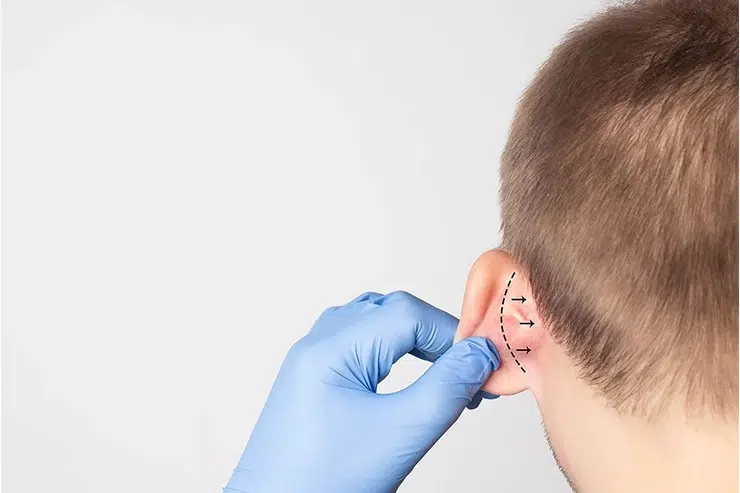Cosmetic Surgery Quote Tunisia
What is the price of otoplasty in Tunisia?
3 days in Tunisia: 2 days at the clinic and 1 day in a 5★ hotel with full board
- The procedure
- Surgeon's fees
- Anesthesiologist fees
- Post-operative follow-up
- Airport reception
- Transport

What is Otoplasty in Tunisia?
Otoplasty is a surgical procedure that addresses prominent or deformed ears. The surgery involves repositioning the ears closer to the head, reducing their size, or reshaping the cartilage for a more aesthetic appearance. Depending on the patient’s needs, it can be performed under local or general anesthesia.

Types of Otoplasty in Tunisia
- Repositioning otoplasty: Adjusts the ears’ position closer to the head.
- Reduction otoplasty: Reduces the size of the ears.
- Cartilage reconstruction: Corrects anomalies in the ear’s cartilage structure.
Preparing for Otoplasty in Tunisia
Before the surgery:
- Medical evaluations: Conduct tests to ensure the patient’s fitness for surgery.
- Pre-operative instructions: Quit smoking, avoid certain medications, and follow dietary advice.
Who is Otoplasty For?
Otoplasty is suitable for:
- Children as young as 5 years old with prominent or deformed ears.
- Adolescents and adults seeking to correct protruding or asymmetrical ears.
- Individuals in good general health with no major contraindications to surgery.
Benefits of Otoplasty in Tunisia
- Surgical expertise: Performed by Dr. Taher Djemal, an experienced plastic surgeon.
- Affordable pricing: Competitive costs compared to Europe and North America.
- Comprehensive management: ServiHealth organizes all aspects of your medical journey.
- Improved aesthetics: Achieve better symmetry and enhanced self-confidence.
Targeted Areas for Otoplasty
- Auricular cartilage (ear structure): Reshaped and repositioned for symmetry.
- Earlobes: Adjusted if needed for proportion and harmony.
How is Otoplasty Performed in Tunisia?
The procedure includes:
- Anesthesia: Local or general, depending on the case.
- Incisions: Made behind the ears to minimize visible scarring.
- Cartilage reshaping: The cartilage is sculpted and secured in place.
- Sutures: Discreetly close the incisions.
- Bandaging: Protects the ears and supports their new position.
Post-Surgery Care for Otoplasty
After surgery:
- Hospitalization: Usually not required unless the case is complex.
- Pain management: Mild discomfort is managed with prescribed painkillers.
- Bandages: Worn for a week to protect and support healing.
- Follow-ups: Regular check-ups with Dr. Djemal to monitor recovery.
Longevity of Otoplasty Results
The results of otoplasty are typically permanent unless impacted by trauma or unforeseen complications. Once healed, the ears maintain their new position and shape.
Tips to Optimize Otoplasty Results
- Follow post-operative care instructions from Dr. Djemal.
- Avoid intense physical activities during the initial weeks.
- Wear the prescribed headband at night for additional protection.
- Maintain good hygiene to prevent infections.
Complementary Procedures for Otoplasty
Otoplasty can be combined with other cosmetic procedures, such as:
- Rhinoplasty (nose surgery)
- Eyelid surgery (blepharoplasty)
- Facelift
- Facial fat grafting
Before & After Otoplasty in Tunisia
Repositioned ears, balanced face, and increased confidence









